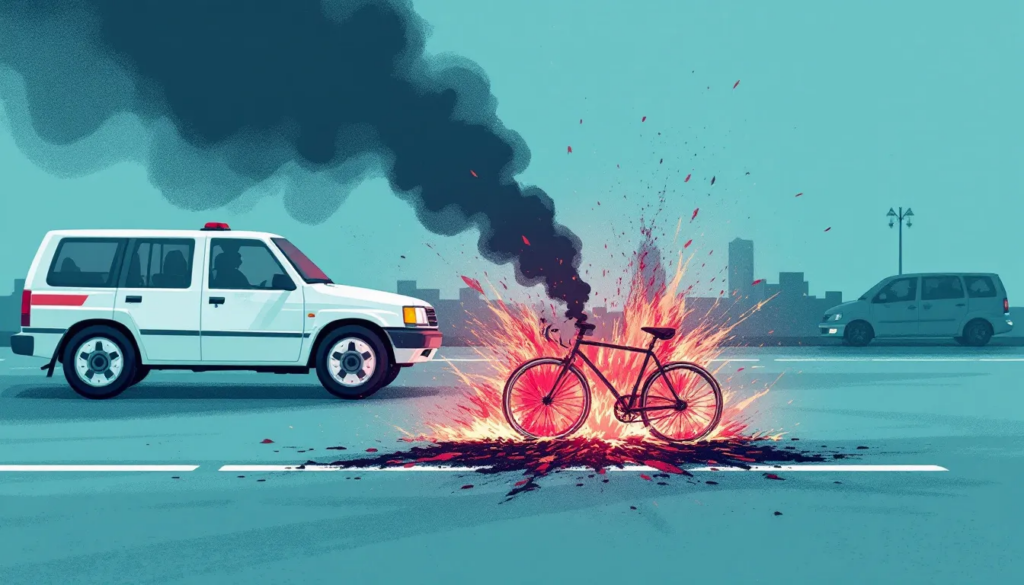Involved in a hit and run bike accident? This guide shows you what to do next: securing your safety, notifying the police, and collecting evidence. Learn your legal options and how to pursue compensation.
Key Takeaways
Prioritize safety, contact authorities, and seek medical attention immediately after a hit and run bike accident.
Gather evidence such as photographs, witness testimonies, and surveillance footage at the accident scene to strengthen your personal injury claim.
Consult with a personal injury attorney to navigate legal options and ensure you receive compensation for medical expenses, lost wages, and pain and suffering.
Immediate Steps After a Hit and Run Bike Accident

In the chaotic aftermath of a hit and run bike accident, your immediate actions can significantly impact your health and the success of any legal claims, especially if you are involved in a hit. Prioritizing your safety, contacting the authorities, and seeking medical attention are the foundational steps that set the stage for all subsequent actions.
Ensure Your Safety First
Your primary concern after a hit-and-run bike accident should be your safety. If possible, move to a safe location away from traffic to avoid further harm. Assess your injuries and prioritize your health by seeking immediate medical attention if needed.
If you are able, try to gather evidence quickly, but do not stay too long at the accident scene to prevent additional risks.
Contact the Police Immediately
Notify the police right away after a hit-and-run bike accident. When reporting the accident, provide as many details as possible, including the location and time of the collision, the direction in which the vehicle was heading, and any identifying details about the car and driver. Obtaining a copy of the police report is vital as it serves as official evidence and can significantly aid in identifying the at-fault driver.
Filing a police report lays the groundwork for any legal process you may pursue later. It documents the incident officially, which is essential for both insurance claims and legal proceedings. If you need to take further steps, it is important to file a police report.
Remember to follow up and obtain a copy of the report for your records. This step is indispensable in the process of seeking justice and compensation for your injuries.
Seek Medical Attention
Medical attention is necessary not only for visible injuries but also to uncover hidden injuries masked by shock and adrenaline. Even if you feel fine, it is crucial to have a healthcare provider evaluate your condition to diagnose and treat any potential injuries.
Communicate clearly with your physician about the bike hit-and-run incident. Detailed medical records will help establish a direct link between the accident and your injuries, which is essential for filing a personal injury claim. This documentation is invaluable when it comes to proving the extent and cause of your injuries in legal and insurance contexts.
Gathering Evidence at the Accident Scene

Collecting evidence at the accident scene is a critical step that can greatly influence the outcome of your personal injury claim. The more detailed and accurate the evidence, the stronger your case will be against the hit and run driver. This includes eyewitness testimonies, surveillance footage, and physical evidence.
Document and Preserve Evidence
Documenting and preserving evidence right after the incident is key to building a strong personal injury case. This can include taking photos and videos of the accident scene, gathering contact information from witnesses, and noting any details about the driver or vehicle involved. Acting quickly is key, as memories fade and conditions at the scene can change.
Keep evidence in its original state. Avoid making any repairs or alterations to your bike or other damaged items until the investigation is complete. Keeping all evidence intact will help your legal team reconstruct the accident and establish liability accurately.
Look for Surveillance Footage
Surveillance footage can provide crucial evidence in hit and run cases. Nearby businesses, traffic cameras, and residential security systems may have captured the incident on video. Obtaining this footage can significantly strengthen your claim by providing clear, undeniable proof of the events.
Look for any available surveillance footage that might have captured the accident.
Reporting and Legal Processes
After ensuring your safety and gathering evidence, the next steps involve reporting the incident and navigating the legal processes. This includes filing a police report and notifying your insurance company, both of which are essential for pursuing compensation and legal action.
Filing a Police Report
A police report is foundational after a hit-and-run bike accident. This official document serves as a formal record of the incident and is crucial for any subsequent legal and insurance claims. When filing the report, provide detailed information such as the vehicle’s license plate number, make and model, color, and any noticeable damage.
Police officers will also gather contact information from witnesses at the scene, which can be invaluable for your case. Make sure to follow up with law enforcement to obtain a copy of the police report, as it will be a critical piece of evidence in your claim.
Notifying Your Insurance Company
Inform your car insurance company about the accident immediately. Provide them with all the details of the crash, including when and where it happened, and the police report number if available. Uninsured motorist coverage can be particularly important in hit-and-run cases, as it can provide compensation even if the at-fault driver is never identified. Contact your driver’s insurance company for further assistance.
Uninsured or underinsured motorist UIM coverage is typically included in most standard insurance policies. This coverage specifically applies to hit-and-run accidents. Having this coverage can help you navigate the financial aftermath of the incident and ensure that your claims are taken seriously.
Pursuing Compensation and Legal Action

Once the immediate steps are taken and the necessary reports filed, the focus shifts to accidents how to pursue compensation and claim or legal action. This process involves consulting with a personal injury attorney, understanding your legal options, and potentially filing an insurance claim or lawsuit.
Consulting with a Bicycle Accident Personal Injury Attorney
A consultation with a bicycle accident personal injury attorney is vital for pursuing compensation. An experienced attorney can conduct thorough investigations, access important legal resources, and negotiate with insurance companies on your behalf. This professional guidance can significantly increase your chances of receiving fair compensation for your injuries.
A personal injury attorney can also provide valuable advice on the feasibility of your case and the best legal strategies to pursue, including the importance of legal representation. Many law firms offer a free consultation, allowing you to discuss your situation without any initial financial commitment.
Choose an attorney who specializes in bicycle accidents and has a proven track record with hit-and-run cases.
Filing an Insurance Claim or Lawsuit
Submitting an insurance claim is typically the first step toward obtaining compensation after a hit-and-run. Most personal injury cases are settled out of court, but understanding the legal processes involved is crucial. Your attorney will guide you through filing the claim, negotiating with insurers, and, if necessary, pursuing a lawsuit.
In California, individuals have two years to file personal injury claims. This period starts from the date of the accident. If the accident resulted in a fatality, families might have the option to file a wrongful death claim. Understanding these timelines and legal options is essential for ensuring that you receive the compensation you are entitled to.
Understanding Compensation for Hit and Run Bicycle Accidents

Victims of hit and run bicycle accidents can pursue various types of compensation, including medical expenses, lost wages, and pain and suffering from run bicycle accident.
Knowing the types of compensation available helps in navigating the aftermath of a hit-and-run to secure maximum compensation.
Medical Expenses and Lost Wages
Medical expenses and lost wages are significant components of compensation in hit and run bicycle accidents. Recoverable medical expenses include hospital visits, physician fees, therapy, medications, and any necessary medical equipment. Compensation for lost wages can cover the recovery period and any future loss of earning capacity due to the injuries sustained.
Keep detailed records like medical documents, doctors’ notes, and receipts to support your claim for medical expenses and lost wages. This evidence will be critical in proving the financial impact of the accident and ensuring you receive fair compensation.
Pain and Suffering
Compensation for pain and suffering addresses the emotional distress, physical pain, and mental anguish resulting from the accident. This type of compensation can be significant, especially in cases involving long-term or permanent injuries.
Keeping a journal to document your emotional challenges can support your claim for non-economic damages.
Pre-Settlement Funding for Bicycle Accident Lawsuits

Pre-settlement funding provides financial relief for victims awaiting compensation from bicycle accident lawsuits. This funding can help cover immediate expenses without added financial strain.
What is Pre-Settlement Funding?
Pre-settlement funding provides cash advances as you await your lawsuit settlement. Unlike a loan, it requires no repayments, with interest capped to prevent compounding fees.
This funding can help cover essential costs while you wait for your case to settle.
Eligibility and Application Process
To qualify for pre-settlement funding, you must have a valid personal injury claim, approval from your attorney, and a pending lawsuit. The application process is quick and does not involve credit checks, making it accessible regardless of your financial status.
Summary
Summarize the key points discussed in the article, reiterating the importance of immediate action, evidence gathering, and legal processes. End with an inspirational note encouraging readers to stay informed and prepared.
Frequently Asked Questions
What should I do immediately after a hit and run bike accident?
Immediately after a hit and run bike accident, prioritize your safety, contact the police, and seek medical attention to document any injuries. Taking these steps is crucial for your well-being and for any potential claims.
How can I gather evidence at the accident scene?
To effectively gather evidence at the accident scene, capture comprehensive photos and videos, collect information from witnesses, and seek out any available surveillance footage. These steps will help establish a clear account of the incident.
Why is filing a police report important?
Filing a police report is important because it creates an official record of the incident, which is essential for any legal actions or insurance claims you may need to pursue.
What types of compensation can I pursue after a hit and run bike accident?
After a hit and run bike accident, you can pursue compensation for medical expenses, lost wages, and pain and suffering. It’s essential to document all losses and consult a legal professional to ensure you explore all available avenues for recovery.
What is pre-settlement funding, and how can it help me?
Pre-settlement funding offers financial support during your wait for lawsuit settlements, alleviating immediate expenses and easing financial pressure. This can be particularly helpful in managing costs like medical bills and daily living expenses until your case is resolved.


